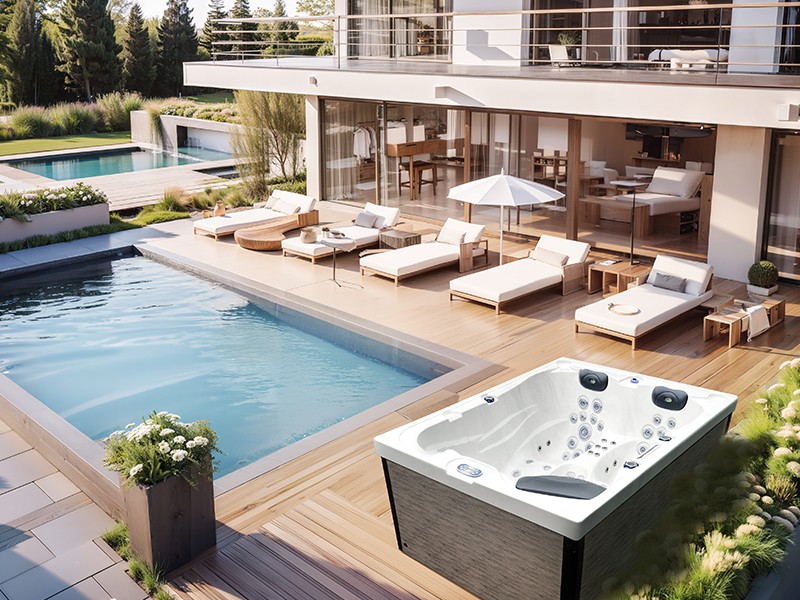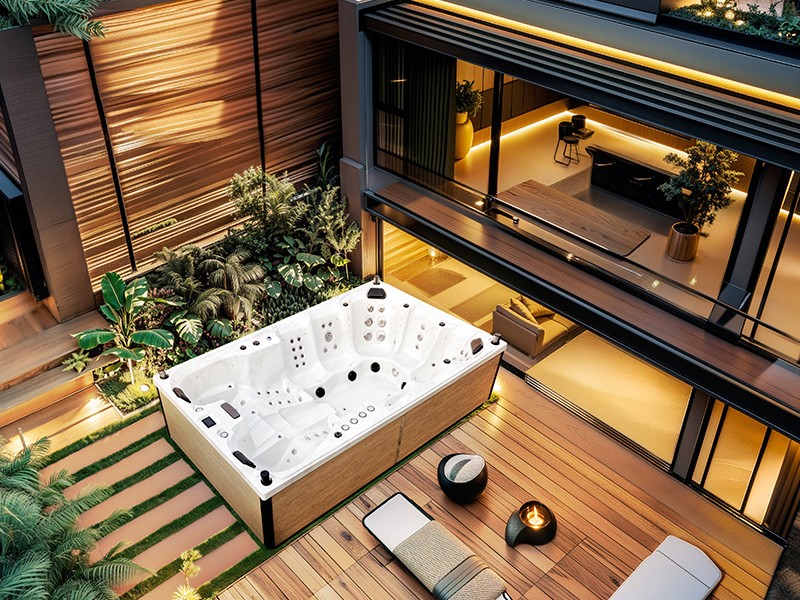
Can I use an outdoor hot tub when it snows?
2024-12-04 15:30In the winter, soaking in an outdoor hot tub is undoubtedly an attractive enjoyment under the white snow. You can feel the warm water wrapped around your body while watching the snowflakes gently fall, as if you are one with nature. However, although this experience is desirable, the question "Can I use an outdoor hot tub when it snows?" deserves serious discussion. The special environmental conditions on snowy days will affect bathing, from safety, health, equipment maintenance to bathing experience, all need to be carefully considered.
This article will discuss the feasibility, potential benefits and possible risks of using an outdoor hot bathtub when it snows in detail from the following aspects.
What are the benefits of soaking in an outdoor hot tub in winter?
Hot bathtubs in winter have many benefits for the body, especially when it snows, the special environment of cold and warm contrast can highlight these benefits.
Benefits of soaking in an outdoor hot tub in winter:
1. Promote blood circulation
2. Soothe muscles and joints
3. Improve immune function
4. Improve mental health
5. Improve sleep quality
Promote blood circulation
Cold weather can cause the body's blood vessels to contract and blood circulation to slow down, especially the extremities are more likely to feel cold. When soaking in a hot bathtub, the water temperature can promote blood vessel dilation and accelerate blood circulation, thereby helping to relieve the symptoms of cold limbs. The contrast between the cold winter temperature and hot water can stimulate the alternating contraction and expansion of blood vessels, thereby improving the efficiency of blood circulation.
Especially on snowy days, when the outside temperature is low, the warmth of hot water can effectively raise body temperature and relieve stiffness and discomfort caused by the cold. At the same time, hot water can also speed up the body's metabolism and promote the discharge of metabolic waste in the body.
Soothe muscles and joints
Cold weather often makes people feel muscle tension and joints are prone to stiffness, especially for the elderly or arthritis patients, the cold in winter may aggravate these symptoms. The buoyancy of hot water can reduce the body's pressure on joints and muscles, and the thermal therapy effect helps relax muscles and relieve pain and stiffness. On snowy days, soaking in hot water can soothe muscles and joints, relieve common winter aches and pains, and help the body recover faster from daily stress.
Improve immune function
Winter is the peak season for influenza and other respiratory infections, and soaking in a hot tub can help stimulate the immune system and strengthen the body's defenses by raising body temperature. The brief rise in body temperature can simulate the process of fever, prompting the immune system to produce more white blood cells to fight potential pathogens. Although this does not directly prevent disease, it does help the body stay healthy.
Improve mental health
Winter often brings mood swings, especially in dark and cold weather, many people feel depressed and even have seasonal affective disorder. Soaking in a hot tub on a snowy day can not only warm the body and promote blood circulation, but also help relieve stress and improve mood through a relaxing and pleasant experience. Hot water can stimulate the secretion of endorphins in the body, a "happy hormone" that helps reduce anxiety and depression.
Improve sleep quality
In the snowy winter, the cold often affects people's sleep quality. Soaking in a hot bathtub can help the body relax and promote sleep. When taking a bath, the body temperature rises, and then gradually drops as the body comes out of the hot water. This cooling process is an important part of the body's preparation for sleep. By taking a hot tub before bed, especially in cold and snowy weather, people can usually fall asleep faster and get a deeper sleep.
What are the potential risks of taking an outdoor hot tub on a snowy day?
Although hot bathtubs do have many benefits on snowy days, they are also accompanied by some potential risks that need to be taken seriously to ensure safety and health.
Potential risks of taking an outdoor hot tub on a snowy day:
1. Risks caused by body temperature fluctuations
2. Risk of dehydration
3. Equipment maintenance and risk of freezing damage
4. Risk of accidental slips
5. Risk of body exposure to cold air
Risks caused by body temperature fluctuations
On snowy days, the outdoor temperature is extremely low, while the water temperature of a hot bathtub is usually kept at around 40 degrees Celsius. This temperature difference may cause the body to face great temperature fluctuations, especially when entering and exiting the bathtub, the body is quickly exposed from a warm environment to cold air, which may cause some health problems.
When the body is exposed to rapid changes in temperature, blood pressure will fluctuate greatly, which can easily cause dizziness, nausea, and even shock. Especially for the elderly and patients with cardiovascular disease, this rapid temperature change may cause more serious cardiovascular events.
Risk of dehydration
When bathing in a hot tub, the human body will sweat a lot to maintain body temperature regulation. Although it is cold in winter, hot water will still accelerate the loss of body fluids. If you don't replenish water in time, you may become dehydrated, especially if you bathe for a long time. This is especially important on snowy days, because the cold outside may make people ignore the actual water loss in the body, causing an increased risk of dehydration.
To prevent dehydration, make sure to drink enough water before bathing in a hot tub, and keep the habit of drinking water while bathing to avoid dizziness or weakness caused by water loss.
Equipment maintenance and risk of frost damage
When using an outdoor hot tub on snowy days, equipment maintenance is crucial. Due to the low outdoor temperature, the water pipes or the water supply system of the bathtub may freeze or be damaged due to the low temperature. Without antifreeze measures, the water in the pipes may freeze, resulting in poor water flow and even pipe ruptures.
To prevent damage to the equipment, users should ensure that the outdoor hot tub has good insulation and antifreeze functions. Modern outdoor hot tubs are usually equipped with heating systems and water pumps to keep the water temperature within a safe range and prevent the pipes from freezing and cracking. Regularly checking the working condition of the equipment to ensure that there are no hidden dangers of leaks or frost damage is an important step when using an outdoor hot tub.
Risk of accidental slips
When it snows, the ground is usually covered with snow, and the slippery ground increases the risk of slips, especially when entering and exiting the hot tub. The temperature change of the body may cause unstable movements and easy falls and injuries. Therefore, it is important to ensure that there are adequate anti-slip measures around the outdoor hot tub.
Laying non-slip mats, ensuring that the steps are dry, and taking careful actions before and after the bath can help reduce the risk of slips. In addition, try to avoid using the hot tub in strong winds or heavy snow, as these weather conditions increase the possibility of hypothermia and accidental falls.
Risks of exposing the body to cold air
Although the body can stay warm in hot water, local hypothermia may occur when the head or other parts not immersed in water are exposed to cold air. Especially in strong winds or heavy snow, the head, shoulders, neck and other parts may feel uncomfortable due to the cold, and even increase the risk of catching a cold or other cold-related diseases.
It is recommended to keep the head and shoulders warm when soaking in a hot bathtub on a snowy day. You can wear a windproof hat or use a towel to cover the parts of the body that are not immersed in water to reduce direct contact with cold air. At the same time, try to choose a time period with less wind to bathe to avoid discomfort caused by cold wind.
How to use an outdoor hot tub safely on a snowy day?
Measures for safe use of outdoor hot tubs on snowy days:
1. Reasonably control water temperature and bathing time
2. Prepare appropriate warming measures
3. Ensure safe entry and exit methods
4. Check equipment status regularly
5. Pay attention to water replenishment
Reasonably control water temperature and bathing time
The water temperature of the hot bathtub should not be too high. It is usually recommended to keep it between 37 and 40 degrees Celsius, which can not only maintain a comfortable experience, but also avoid cardiovascular problems caused by excessive temperature. At the same time, the bathing time should also be controlled. Usually, each bath should not exceed 20 to 30 minutes. If you experience discomfort symptoms such as dizziness and palpitations, you should stop bathing immediately and leave the hot water.
Prepare appropriate warming measures
When bathing on snowy days, although the body is soaked in hot water, the head and other parts that are not soaked in water need to be kept warm. You can prepare windproof towels, warm clothes, hot drinks, etc., so that you can put them on immediately when you leave the hot tub to reduce the discomfort caused by the sudden drop in temperature.
Ensure safe entry and exit
When entering and exiting the hot tub, make sure there are stable handrails or non-slip mats to reduce the risk of slipping. In addition, choose a dry, flat path to the tub to ensure your safety. After leaving the hot tub, quickly dry yourself with a dry towel and change into warm clothes to prevent catching a cold.
Check the equipment status regularly
Before using an outdoor hot bathtub, regularly check the insulation and antifreeze functions of the equipment to ensure that there are no hidden dangers such as leaks and frost damage. Consider cleaning and maintenance before use in winter to keep the equipment in good working condition.
Pay attention to water replenishment
It is important to stay hydrated during the bathing process. You can drink warm water or other hot drinks before and after the bath to replenish the lost water and avoid discomfort caused by dehydration.
Discover the perfect blend of affordability and performance with Guangzhou HuanTong Industrial’s outdoor spa range. As one of the largest manufacturers and suppliers in China, we offer cheap prices and high-quality products through our Lovia Spa brand, a trusted name in the market.




